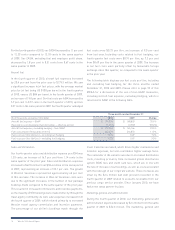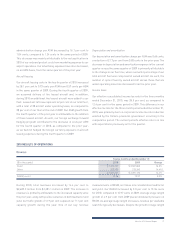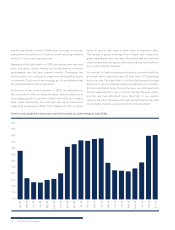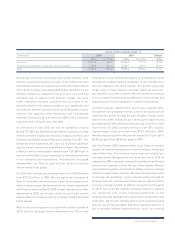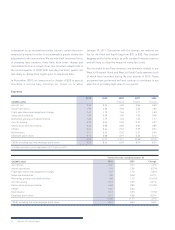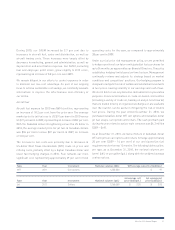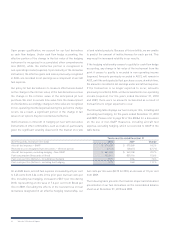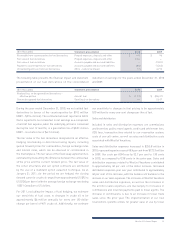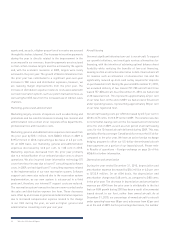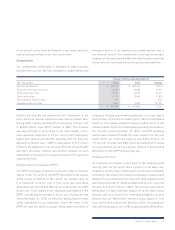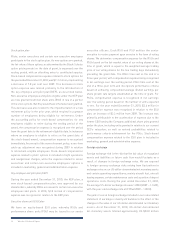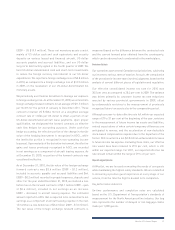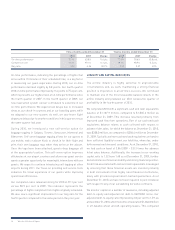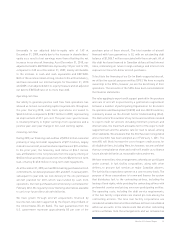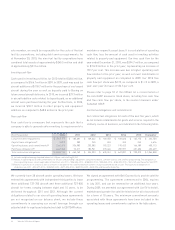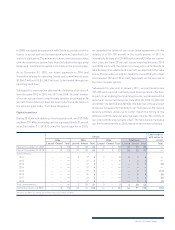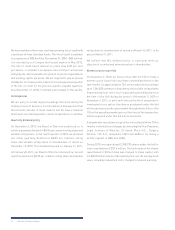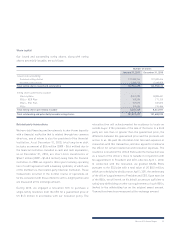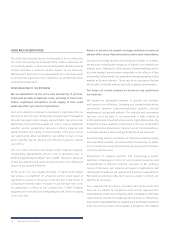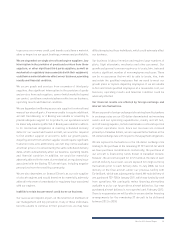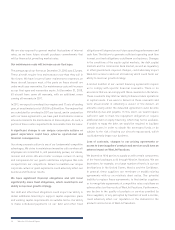Westjet 2010 Annual Report Download - page 28
Download and view the complete annual report
Please find page 28 of the 2010 Westjet annual report below. You can navigate through the pages in the report by either clicking on the pages listed below, or by using the keyword search tool below to find specific information within the annual report.
26 WestJet 2010 Annual Report
Stock option plan
Pilots, senior executives and certain non-executive employees
participate in the stock option plan. As new options are granted,
the fair value of these options, as determined by the Black-Scholes
option pricing model on the date of grant, is expensed over the
vesting period, with an offsetting entry to contributed surplus.
Stock-based compensation expense related to stock options for
the year ended December 31, 2010, was $11.1 million, representing
a decrease of 7.8 per cent over 2009. This decrease in stock
option expense was related primarily to the introduction of
the key employee and pilot plan (KEP), as described below.
Non-executive employees and pilots eligible under the KEP plan
are now granted restricted share units (RSU) in lieu of a portion
of the stock options that they would have otherwise been granted.
This decrease was also related to the implementation of a new
retirement policy in the prior year, which resulted in a greater
number of employees being eligible for retirement. Under
the accounting policy for stock-based compensation, for any
employees eligible to retire during the vesting period of the
award, the compensation expense is recognized over the period
from the grant date to the retirement eligibility date. In instances
where an employee is eligible to retire on the grant date of
the stock-based award, compensation expense is recognized
immediately. As a result of the new retirement policy, a one-time
catch-up adjustment was recognized during 2009 in relation
to retirement-eligible employees. Stock-based compensation
expense related to pilots’ options is included in flight operations
and navigational charges, while the expense related to senior
executives’ and certain non-executive employees’ options is
included in marketing, general and administration expense.
Key employee and pilot plan (KEP)
During the year ended December 31, 2010, the KEP plan, a
new stock-based compensation plan, was approved by our
shareholders, whereby RSUs are issued to certain non-executive
employees and pilots. In 2010, $1.0 million of compensation
expense was recognized in relation to the KEP plan.
Executive share unit (ESU) plan
We have an equity-based ESU plan, whereby RSUs and
performance share units (PSU) may be issued to our senior
executive officers. Each RSU and PSU entitles the senior
executive to receive payment upon exercise in the form of voting
shares. We determine compensation expense for the RSUs and
PSUs based on the fair market value of our voting shares at the
time of grant, which is equal to the weighted average trading
price of our voting shares for the five trading days immediately
preceding the grant date. The RSUs time vest at the end of a
three-year period, with compensation expense being recognized
in net earnings over the vesting period. PSUs time vest at the
end of a three-year term and incorporate performance criteria
based on achieving compounded average diluted earnings per
share growth rate targets established at the time of grant. For
PSUs, compensation expense is recognized in net earnings
over the vesting period based on the number of units expected
to vest. For the year ended December 31, 2010, $3.6 million in
compensation expense was recognized in relation to the ESU
plan, an increase of $2.2 million from 2009. The increase was
primarily attributable to the acceleration of expense due to the
former CEO leaving the Company; additional share units granted
under the plan, including units granted in relation to our current
CEO’s relocation; as well as revised probabilities related to
performance criteria achievement for the PSUs. Stock-based
compensation expense related to the ESU plan is included in
marketing, general and administration expense.
Foreign exchange
Foreign exchange risk is the risk that the fair value of recognized
assets and liabilities or future cash flow would fluctuate as a
result of changes in foreign exchange rates. We are exposed
to foreign currency exchange risks arising from fluctuations in
exchange rates on our US-dollar-denominated net monetary assets
and certain operating expenditures, mainly aircraft fuel, aircraft
leasing expense, certain maintenance costs and a portion of airport
operations costs. During the year ended December 31, 2010,
the average US-dollar exchange rate was 1.0302 (2009 – 1.1425),
with the year-end exchange rate at 0.9946 (2009 – 1.0510).
The gain or loss on foreign exchange included in our consolidated
statement of earnings is mainly attributable to the effect of the
changes in the value of our US-dollar-denominated net monetary
assets. As at December 31, 2010, US-dollar-denominated
net monetary assets totalled approximately US $53.0 million


